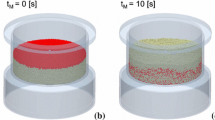Abstract
UNTIL recently, the only accepted theory of powder mixing was based on a statistical randomisation of non-cohesive particles1. The introduction of the concept of ordered mixing2 enables a logical theory to be established for the mixing of small cohesive particles to a considerable degree of homogeneity. The concept of ordered mixing has attracted considerable support3–5. A basic principle of ordered mixing is that fine particles will adhere, especially to larger particles. The adhesional forces involved may be electrostatic or surface tensional. For a homogeneous system to be formed, the weight of fine particles adhering to unit surface area of the larger particles should be constant. We report here such a condition in the mixing of a fluid energy milled closely sized fraction (2.6 µm) of salicylic acid with a multi-sized distribution of sucrose crystals, in the ratio 1 : 1,000 by weight.
Similar content being viewed by others
References
Lacey, P. M. C., Trans. Inst. chem. Engrs, Lond., 21, 53–59 (1943).
Hersey, J. A., Powder Technol., 11, 41–44 (1975).
Travers, D. N., Powder Technol., 12, 189–190 (1975).
Kristensen, H. G., Powder Technol., 13, 103–121 (1976).
Crooks, M. J., Aust. J. pharm. Sci., NS 5, 25–31 (1976).
Author information
Authors and Affiliations
Rights and permissions
About this article
Cite this article
YIP, C., HERSEY, J. Ordered powder mixing. Nature 262, 202–203 (1976). https://doi.org/10.1038/262202a0
Received:
Accepted:
Published:
Issue Date:
DOI: https://doi.org/10.1038/262202a0
- Springer Nature Limited





